Working professionals
Fresh graduates
- Study abroad
- Offline centres
More
27. Columns in Excel
33. Count In Excel
49. Slicers in Excel
54. Solver in Excel
56. Macros In Excel
Count in Excel: What It Is and How to Use It Easily
For me, Excel is not just software; it's an indispensable multifunctional tool that helps me visually represent data with efficiency. My proficiency in using Excel's charting and graphing capabilities has been pivotal. However, integrating the COUNT in Excel function into my daily tasks has revolutionized the way I manage and interpret datasets and learn how to count in Excel.
This function simplifies data analysis by swiftly tallying the number of entries in a range based on a specific criterion. With COUNT in Excel, managing intricate datasets becomes effortless. Which is why I have designed this beginner-friendly tutorial for you.
Here you will learn in-detail about this basic yet highly useful function. However, to make things way more easy career-wise, I would strongly suggest you take up a Data Analysis course to master functions like COUNT in Excel.
Understanding Count in Excel
Excel's COUNT function is an essential tool designed to quantify the number of cells within a specified range that contains numerical data. To activate this function, you have to initiate it with the syntax
`=COUNT`
Count Function in Excel
The COUNT function in Excel is used specifically to tally up the number of cells in a given range that contain numeric entries. The count in Excel formula is `=COUNT`.
Delineating the COUNT Function's Use Cases:
Important to highlight is the COUNT function's exclusive attention to numeric data within cells. For counting instances involving text, use the COUNTA function.
Implementing the COUNT Function:
1. Select your desired cell for the function's output.
2. Input `=COUNT` to activate the function.
3. When the COUNT command appears, choose it to move forward.
4. Specify the range of cells you intend to count.
5. Conclude with the enter key.
Practical Example:
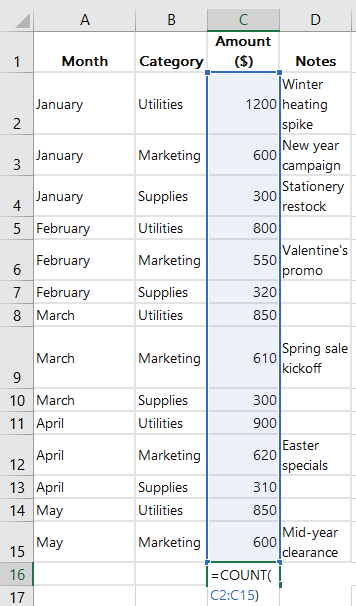
Source: MS Excel
Let's apply the COUNT function to a new scenario, for instance, evaluating the range C2:C15 for the number of entries recording employee hours worked, which are purely numeric.
Step-by-step guide on how to use count in Excel:
- Begin by selecting cell C16.
- Input the command `=COUNT`.
- From the function prompt, choose the range C2:C15.
- Finalize the action with an enter press.
Through this process, assuming the range C2:C15 is fully populated with numbers, the COUNT in Excel function meticulously calculates the total number of entries, potentially returning a count of 14 if each cell within the range is filled with numeric data.

Source: MS Excel
Demonstrating a Constraint:

Source: MS Excel
The COUNT in Excel function does exhibit limitations, particularly with non-numeric data types. Applying it, for example, to the range B2:B15, which might be filled with names rather than numeric data, illustrates this point.
The outcome in such a case would be zero since the function exclusively recognizes and counts numeric entries, leaving textual data uncounted. This example underscores the necessity of selecting the appropriate function based on the data type present within the target range.
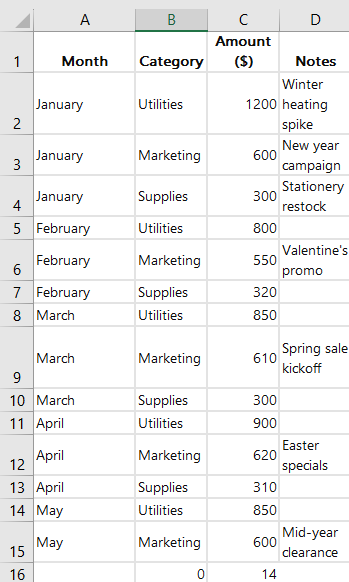
Source: MS Excel
How to Use the COUNTIF Function in Excel?
This function is your go-to solution for counting cells across multiple ranges based on specific criteria. It's beneficial for data analysis across various scenarios.
The first step is to break down the COUNTIFS syntax:
=COUNTIFS(criteria_range1, criteria1, [criteria_range2, criteria2], ...)
In this formula, `criteria_range1` and `criteria_range2` are the cells you're examining, while `criteria1` and `criteria2` represent the conditions those cells must meet.
The criteria can help you identify things like:
- If a number is greater (`>`) or lesser (`<`) than a specific value.
- If a cell's content matches (`=`) a certain text string.
It's important to note that the list of ranges and criteria can be extended as needed, and depending on your system's settings, you might separate items in the function with commas (`,`) or semicolons (`;`).
A Fresh Example: Analyzing Sales Data
Consider you're analyzing sales data and want to count the number of transactions that exceed $500 in value made by salesperson "Alex".
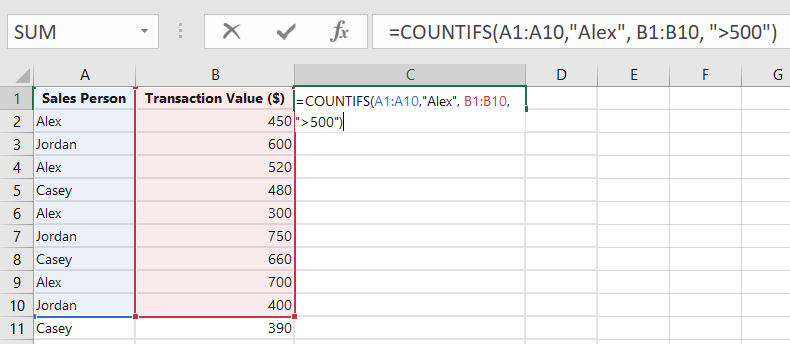
Source: MS Excel
Follow the given steps:
1. Cell A1 to A10 lists salespersons' names, and B1 to B10 lists the transaction values.
2. Click on the cell where you want to display the count; In this case, let’s choose C1.
3. Type in `=COUNTIFS` and start your formula.
4. For the first range, select A1:A10, as you're checking names. After a comma, specify `"Alex"` as your criteria, enclosed in quotes.
5. Add another comma to introduce your second condition. Now, select B1:B10 as your second range, because you're examining transaction values.
6. After another comma, enter `">500"` to set your monetary condition, also enclosed in quotes.
7. Hit Enter.
Now, cell C1 will show you the number of transactions over $500 made by Alex.

Source: MS Excel
This function isn't limited to sales data. You can adapt it to count anything from specific grades in a class to entries within a certain date range in a schedule.
COUNTIF Function Use: An Alternative Scenario
Imagine a teacher who wants to spot students shining in both Math and Science. They create a table with columns for student names, Math scores, and Science scores, all out of 100. The goal is to pinpoint students scoring above 85 in both subjects to identify top performers.
Using COUNTIFS for Analysis
To determine this, the COUNTIFS function is applied. In an empty cell, you need to input the function:
=COUNTIFS(B2:B9, ">85", C2:C9, ">85")
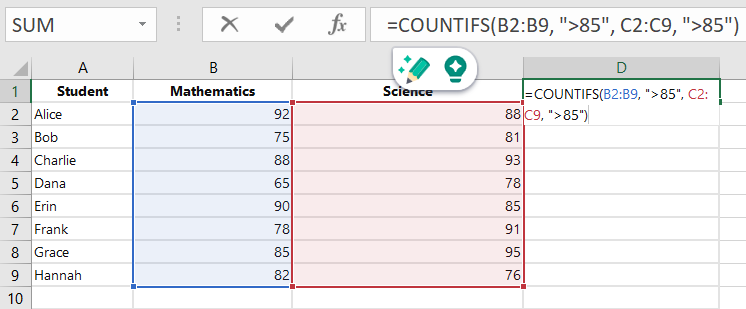
Source: MS Excel
This formula is structured to count the instances within the specified ranges (B2:B9 for Mathematics and C2:C9 for Science) where the scores exceed 85, fulfilling both conditions simultaneously.
Interpreting the Result
After applying the COUNTIFS formula, the output reveals that three students (Alice, Charlie, and Grace) achieved scores above 85 in both subjects. This indicates their strong performance in subjects, pinpointing them as top performers.
By entering the function into Excel, you obtain the value 2, reflecting these students' outstanding achievements.
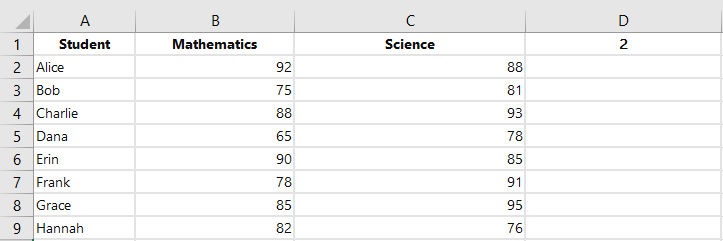
Source: MS Excel
This approach demonstrates the practical application of COUNTIFS in an educational context, offering a straightforward method for teachers to recognize students excelling in critical subjects.
How to Use the COUNTA Function in Excel?
Let me introduce you to the COUNTA function in Excel, a handy feature that proved invaluable as I cataloged my extensive book collection. The beauty of COUNTA lies in its ability to count in Excel, both numbers and text, tallying any cell that holds data.
Here's a step-by-step guide to how I applied the COUNTA function, drawing from my use case:
- Initiating the COUNTA Function: Begin by selecting the cell where the result of the COUNTA function will be displayed. This cell will show the total count of non-empty cells within the specified range.
- Entering the Function: In the selected cell, enter `=COUNTA(` to initiate the function. This action prepares Excel to perform the count based on the range of cells that will be specified next.
- Specifying the Range: After typing `=COUNTA(`, the next step is to specify the range of cells to count. For example, if counting items listed from cells A2 to A21, this range is highlighted or typed directly into the formula, resulting in `=COUNTA(A2:A21)`.
- Executing the Command: Now press Enter after typing in the complete formula. Excel will then calculate and display the number of cells that contain data in the specified range.
Consider applying the COUNTA function to different scenarios to understand its utility. For instance, if there's a list of book titles in column B, from B2 to B21, and a desire to count how many books are listed, applying `
=COUNTA(B2:B21)`
in an adjacent cell will yield the total count of books.

Source: MS Excel

Source: MS Excel
Similarly, if there's a column with numerical values, such as inventory quantities or issue numbers for a collection of magazines listed from D2 to D21, the COUNTA function works just the same. Inputting `=COUNTA(D2:D21)` next to this column will provide the total entries count.
Row Count and Letter Count in Excel
- Row Count: The row count in Excel refers to the total number of rows available in a worksheet, which can vary between Excel versions; for instance, Excel 2007 and later versions support up to 1,048,576 rows. To count specific data rows, functions like COUNT or COUNTA can be used.
- Letter Count: Letter count in Excel involves counting characters in a cell or range of cells, achievable with the LEN function. For example, `=LEN(A1)` calculates the number of characters in cell A1. Combining LEN with other functions can analyze text data efficiently.
There are many more effective Excel functions to help save time spent in performing tasks that you would otherwise perform manually. If you want to master this software, by learning more functions like COUNT in Excel consider taking up a professional certification course.
Final Note
Excel proves itself as an indispensable tool in data management and analysis. With functions like COUNT in Excel and its various subset formulae like COUNTIF, and COUNTA at the core of its utility. These functions are just the tip of the iceberg in what you can achieve with Excel, offering a gateway to efficiently handle, analyze, and draw insights from your data.
I have used Excel ever since I started working. All I can say is that it continues to evolve. Hence, staying updated with new features and exploring advanced functions can significantly enhance your analytical capabilities.
On this note, I would highly recommend you check out the professional courses offered by upGrad. These programs, designed by industry experts can not only boost your knowledge but also, give you a better shot at building your career the way you want to.
Frequently Asked Questions
1. How do I count text cells in Excel?
Use the COUNTA function of count in Excel for tallying cells filled with text. It scans a range and counts cells that aren't empty, including those with textual content. How do I count fill cells in Excel?
2. How do I count fill cells in Excel?
`COUNTA` comes into play again when you need to count cells that are not empty, covering any data type. It's your go-to for a comprehensive cell count. How do I count a list of names in Excel?
3. How do I count a list of names in Excel?
When dealing with names, `COUNTA` effectively counts each entry, since it's aimed towards non-empty cells, making it perfect for lists of textual data like names. How do you find the count of a list?
4. How do you find the count of a list?
To determine the total items in a list, the approach varies: `COUNTA` for any data type, and `COUNT` specifically hones in on numerical entries, providing versatility based on content. What is counted in a list?
5. What is counted in a list?
The term implies tallying items within a list, with `COUNT` focusing on numbers, while `COUNTA` includes every data type, offering flexibility in counting methods. Can you use count on a list?
6. Can you use count on a list?
Indeed, `COUNT` is for numerical data in a list. For a broader application covering all data types, `COUNTA` is the method of choice. How do I count specific items in a list?
7. How do I count specific items in a list?
For targeted counting, such as how many times a particular item appears, `COUNTIF` or `COUNTIFS` are tailored for the job. They allow setting specific conditions, making them ideal for complex data analysis.

Author|15 articles published


upGrad Learner Support
Talk to our experts. We are available 7 days a week, 10 AM to 7 PM
Indian Nationals
Foreign Nationals
Disclaimer
The above statistics depend on various factors and individual results may vary. Past performance is no guarantee of future results.
The student assumes full responsibility for all expenses associated with visas, travel, & related costs. upGrad does not .






















-7f4b4f34e09d42bfa73b58f4a230cffa.webp&w=128&q=75)
-ae8d039bbd2a41318308f8d26b52ac8f.svg)



